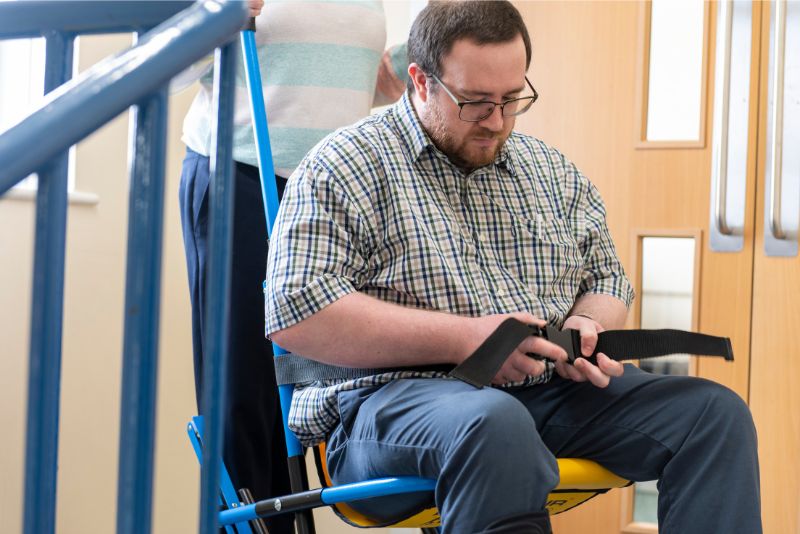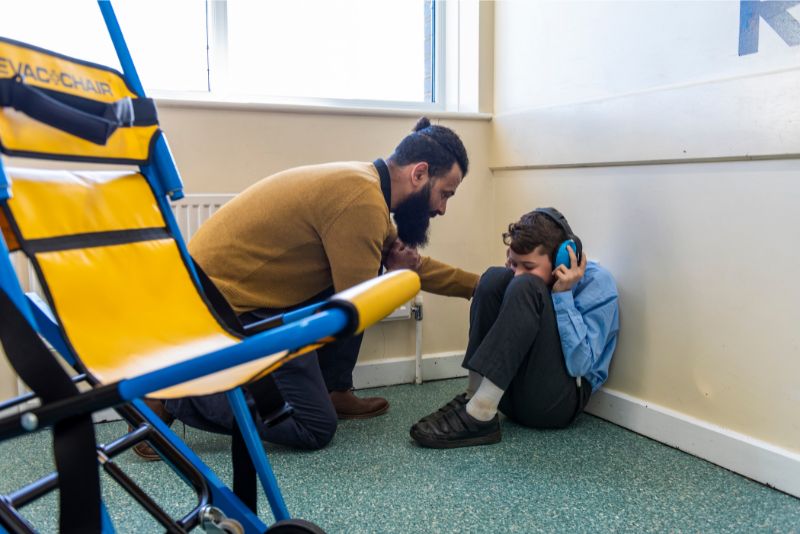-
Contact
Sales & Customer Service
0800 612 6537 support@safelincs.co.uk Live ChatDelivery Enquiries
0800 077 6149 - Resources
Fire & Safety Solutions
CALL OUR TEAM NOW 0800 612 6537
Also FREE from UK mobiles
Free Delivery
on 100s of Products
Live Chat - Online
Instant help & Advice
Trade Discounts
and exclusive pricing
0% Credit Available
Open an account now
5 Star Customer Feedback
Evacuation Equipment Legal Requirements
Is it a legal requirement to have an evacuation chair?
There is no single piece of legislation that mandates the installation of evacuation equipment. However, there is existing legislation that, when cross-referenced, would enforce such installation in many circumstances.
The Regulatory Reform (Fire Safety) Order 2005 (RRFSO) states that the responsible person must ‘take such general fire precautions as will ensure, so far as is reasonably practicable, the safety of any of his employees’, and ‘take such general fire precautions as may reasonably be required in the circumstances of the case to ensure that the premises are safe’ for visitors.
General fire precautions should include
- measures to reduce the risk of fire on the premises and the risk of the spread of fire on the premises;
- measures in relation to the means of escape from the premises;
- measures for securing that, at all material times, the means of escape can be safely and effectively used
Therefore, safe and effective means of escape must be available to all building users, including employees and visitors.

When the RRFSO is cross-referenced against the Equality Act 2010, it becomes even clearer that the means of evacuation for disabled people must be accounted for. Under the section 'Adjustments for disabled persons', the Equality Act 2010 states organisations have a duty to make adjustments in the following circumstances:
‘Where this Act imposes a duty to make reasonable adjustments on a person, this section, sections 21 and 22 and the applicable Schedule apply; and for those purposes, a person on whom the duty is imposed is referred to as A.
The duty comprises the following three requirements:
- The first requirement is a requirement, where a provision, criterion or practice of A's puts a disabled person at a substantial disadvantage in relation to a relevant matter in comparison with persons who are not disabled, to take such steps as it is reasonable to have to take to avoid the disadvantage.
- The second requirement is a requirement, where a physical feature puts a disabled person at a substantial disadvantage in relation to a relevant matter in comparison with persons who are not disabled, to take such steps as it is reasonable to have to take to avoid the disadvantage.
- The third requirement is a requirement, where a disabled person would, but for the provision of an auxiliary aid, be put at a substantial disadvantage in relation to a relevant matter in comparison with persons who are not disabled, to take such steps as it is reasonable to have to take to provide the auxiliary aid.’
When considered as a whole, the legislative guidance can be condensed down to the following key points:
- The escape route must be clear and available at all times, to all people.
- Any auxiliary evacuation aids that can reasonably be foreseen as necessary should be provided – failure to do so is discriminatory.
Who Does Evacuation Equipment Legislation Apply To?
The final responsibility to ensure premises conform to the Regulatory Reform (Fire Safety) Order 2005 lies with the 'responsible person'. The responsible person might be the employer, the managing agent or owner, or another appointed person.
The Equality Act 2010 is a wide-ranging piece of legislation that was introduced to replace the previous equality laws - The Equal Pay Act 1970, The Sex Discrimination Act 1975, The Race Relations Act 1976 and The Disability Discrimination Act 1995. It is applicable to anyone classed as an employer or service provider. A service provider is defined as anyone providing goods, facilities or services to the general public, either at a charge or for free.
Therefore, the responsibilities outlined by the RRFSO and the Equality Act 2010 are applicable to any organisation employing people and/or providing services to the general public; it is the legal duty of the responsible person within the organisation to ensure that these responsibilities have been met.

Does my building need evacuation equipment?
The main challenge when evacuating people with limited mobility is putting in place a system to safely manage the descent of stairs. The use of lifts is usually restricted in the event of a fire. Therefore, any building which has employees who require the use of a lift to change level will need access to an alternative escape route, which can often be facilitated by an evacuation device.
All public or commercial buildings are required under the Regulatory Reform (Fire Safety) Order 2005 to have an up-to-date Fire Risk Assessment. Part of this assessment should appraise the escape routes and highlight any failings in relation to evacuation of the occupants of a building. However, 25% of decision makers report that they are unaware of the number of people in their organisation who would need assistance to evacuate in an emergency.
A building that is open to the public must have in place an evacuation plan that accounts for the safe escape of visitors with limited mobility. Therefore, any multi-storey premises which allows visitors or members of the public on site should consider evacuation equipment, even if no staff or residents report mobility limitations.
22% of adults in the UK report living with a disability of some kind, which includes both physical disabilities, and hidden disabilities, such as autism or anxiety, which employers are more likely to overlook. Temporary conditions, such as injury or pregnancy, can also inhibit mobility, and should be anticipated when conducting fire risk assessments. There is a significant likelihood that someone living, working in, or visiting any multi-storey building would need assistance to escape. Therefore, even if a multi-storey premises has no staff or residents who would require assistance to escape, it is reasonable to anticipate that a visitor would, or that a short-term mobility restriction will arise for a permanent building user.

Legislation for evacuation in high rise residential buildings
Fire Safety Regulations released in 2022 have imposed new duties on responsible persons of buildings which contain two or more sets of domestic premises, or which contain common parts through which residents would need to evacuate in the case of an emergency. These responsibilities include the display of easily comprehensible fire safety instructions (the evacuation strategy for the building, instructions on how to report a fire, and any other instruction that tells residents what they must do when a fire has occurred). Further to this, all fire doors in communal areas must be checked for compliance at least every three months, and flat entrance doors must be checked annually. All non-compliant doors must be replaced.
Conclusions of a consultation on ‘Personal Emergency Evacuation Plans in high-rise residential buildings: Equality Impact Assessment’ could soon bring additional responsibilities for responsible persons of these buildings into law. This includes the requirement of PEEPs (Personal Emergency Evacuation Plans) for all residents who have identified themselves to the responsible person as having protected characteristics which would prevent them from evacuating unassisted. A template to support responsible persons to develop these plans in conjunction with the individual will be made available.

Evacuation plans
- PEEPs
If a regular occupant of, or visitor to a building has a particular difficulty that would affect their ability to escape the building in an emergency, this should be guarded against by the creation of a Personal Emergency Evacuation Plan, or PEEP. These personalised plans are designed to appraise the specific needs of an individual and can often lead to additional equipment or processes being identified as necessary. For example:
"A health club has a regular member who finds the stairs difficult. During their induction, the fitness instructor discusses their escape needs. An evacuation chair is provided at gym level. All instructors are trained in the use of the chair and they are introduced to the member." - Fire safety risk assessment - Supplementary guide: Means of Escape for Disabled People.
In this example the organisation is responding appropriately to the specific needs of an individual, and therefore avoiding any discrimination caused by failing to account for their requirements.
- GEEPs
A General Emergency Evacuation Plan is a plan that should be followed by building users in an emergency. It must include a building’s layout, evacuation procedures, equipment, and relevant communication devices. In a public building, a GEEP must be in place for all visitors to see.
Although they are useful for all visitors, GEEPs are essential for visitors with restricted mobility, or those who can’t evacuate unaided. GEEPs provide the information these people need to do so safely and effectively, and regular drills must be carried out to ensure that the GEEP is adequate and up to date.
Phased And Horizontal Evacuation – A Component, NOT an Alternative
Larger or more complicated environments such as hospitals or office complexes often implement a system known as phased evacuation. A phased evacuation raises the alarm in selected areas of the premises sequentially, giving priority to the areas most at risk from the fire. This is done to ensure that escape routes are not overloaded or to prevent vulnerable people from having to evacuate unnecessarily.
Horizontal evacuation is a concept that is often associated with large scale evacuations of multi-story buildings. To enable this as an option, buildings providing care for immobile patients are expected to exhibit the very highest standards of compartmentalisation. This allows trained staff members to initially move patients horizontally, past a minimum of two fire doors as a first stage evacuation.
While horizontal and phased evacuations can therefore delay the immediate need to transfer patients between levels, a system must still be in place to evacuate everyone from the building. It is not acceptable for an evacuation plan to divert individuals with limited mobility to refuge areas to await rescue from emergency services. These evacuation strategies can buy time and improve the safety of individuals who need assistance, but an evacuation device is still required.
Reviewed: 28/06/2023 (doc:762 V1.0). Our articles are reviewed regularly. However, any changes made to standards or legislation following the review date will not have been considered. Please note that we provide abridged, easy-to-understand guidance. To make detailed decisions about your fire safety provisions, you might require further advice or need to consult the full standards and legislation.



















